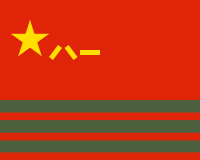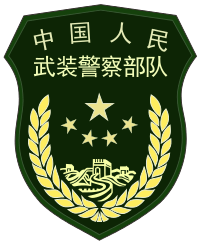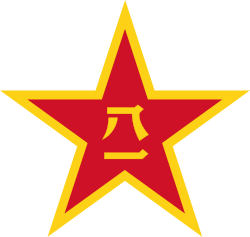People's Armed Police
| Chinese People's Armed Police Force (PAP) | |
|---|---|
| 中国人民武装警察部队 (武警) | |
 _cap_insignia.svg.png) Flag and Badge of the People's Armed Police | |
| Active | June 19, 1982 – present |
| Country |
|
| Allegiance |
|
| Branch |
PAP Internal Guard Corps (including PAP Mobile Corps) PAP Coastal Guard Corps |
| Type | Gendarmerie/Paramilitary |
| Role | Preservation of Public Order and Security, Civil Defence, Reserves, Coast Guard duties |
| Size | 1.5 million |
| Part of |
Armed Forces of the People's Republic of China (under the Central Military Commission) |
| Garrison/HQ | Haidian District, Beijing, China |
| Colours | Red, Olive green |
| Commanders | |
| Commander | PAP General Wang Ning |
| Political Commissar | PAP Lt Gen Zhu Shengling |
| Insignia | |
| Armband |
 |
| Emblem of PAP helicopters |
 |
| Emblem of PAP Forestry Troops (abolished 2018) helicopters |
 |
| Chinese People's Armed Police Force | |||||||
| Simplified Chinese | 中国人民武装警察部队 | ||||||
|---|---|---|---|---|---|---|---|
| Traditional Chinese | 中國人民武裝警察部隊 | ||||||
| |||||||
| People's Armed Police | |||||||
| Simplified Chinese | 人民武装警察 | ||||||
| Traditional Chinese | 人民武裝警察 | ||||||
| |||||||
| China Armed Police | |||||||
| Simplified Chinese | 中国武警 | ||||||
| Traditional Chinese | 中國武警 | ||||||
| |||||||
| Short form | |||||||
| Simplified Chinese | 武警[部队] | ||||||
| Traditional Chinese | 武警[部隊] | ||||||
| Literal meaning | Armed Police [Force] | ||||||
| |||||||
The Chinese People's Armed Police Force (abbreviated: PAP) is a Chinese paramilitary police (Gendarmerie) force primarily responsible for internal security, law enforcement and maritime rights protection in China, as well as providing support to the PLA Ground Force during wartime.
In the contrast to the People's Police officers in Public Security and other law enforcement agencies, PAP servicepersons, also called as "Armed Police officers and soldiers" (武警官兵), wear olive green instead of the blue uniforms of the People's Police.
The PAP is estimated to have a total strength of 1.5 million.
History
The history of the People's Armed Police is as long as that of the People's Republic, and its origin can be traced back to the People's Liberation Army, which was responsible for both defending the nation from foreign invasions and internal security. Although the force was officially established in 1982, its constituent units stretch back to 1949.[1] After the establishment of the People's Republic of China, it was soon apparent that the different troops were required for the vastly different missions, and the domestic security functions had to be removed from the People's Liberation Army. As a result, the portion of People's Liberation Army responsible for internal security and other domestic police missions branched out to form the Public Security Army, under the administration of the Ministry of Public Security of the People's Republic of China. Although under the Ministry of Public Security, the Public Security Army troops were not exactly public security police officers because in addition to regular police work, they were also tasked with secondary military tasks which was not part of the responsibility of regular police officers of the public security ministry.
After numerous name changes and reorganization, the PAP was created on June 19, 1982, by an amalgamation of the PLA's border control, security units and fire department, as well as from Ministry of Public Security units. The establishment of the People's Armed Police marked the efforts to professionalize the security apparatus, as well as the absorption of numerous PLA demobilized personnel,[2]:228-229 in the wake of a growing unrest.[2]:229
Up until 2013, the China Coast Guard was a part of the PAP, but it was separated, since then it reports directly to the Ministry of Public Security and the State Oceanic Administration. However, in March 2018, it has been announced that the Coast Guard shall be placed under the People's Armed Police Force once again as the State Oceanic Administration has been disbanded.[3]
Mission
The People's Armed Police's primary mission is internal security. The first law on the People's Armed Police, the Law on the People's Armed Police Force (PAPF), was passed in August 2009, giving it statutory authority to respond to riots, terrorist attacks or other emergencies.[4][5] Such units guard government buildings at all levels (including party and state organisations, foreign embassies and consulates), provide security to public corporations and major public events, as well as counter-terrorism and handling of public emergencies.[6] Some units perform guard duty in civilian prisons and provide executioners for the state. The PAP also maintains tactical counter-terrorism (CT) units in the Immediate Action Unit (IAU), Snow Wolf Commando Unit (SWCU) and various Special Police Units (SPUs).
The PAP maintains division-sized mechanized infantry unit and a rapid deployment light motorized infantry unit, these units are tasked with responding to any possible armed mutinies by PLA soldiers. In wartime deployments the PAP can act as light infantry supporting the PLAGF in local defense missions and in support of the PLAN in naval operations.[7]:87
Organization
.jpg)
Until 31 December 2017, the People's Armed Police had a dual command structure including the Central Military Commission (CMC) and the State Council through the Ministry of Public Security.[7]:18
By law however, the PAP operates separately from the PLA.[7]:18 and, in terms of conducting public security operations and relevant capability building, the PAP Headquarters is under the leadership and command of the Ministry of Public Security.
From 1 January 2018, command of the People's Armed Police is jointly held by the Central Committee of the Communist Party of China and the Central Military Commission, with the PAP no longer subordinate to the State Council.[8][9]
The reform was reportedly carried out in order to deprive the local Party authorities of the power to use the PAP units to commit abuses or even against the leadership in Beijing. With the new organization, local authorities need central approval in order to deploy the PAP.[10]
Prior to the 2018 reform, the People's Armed Police was further divided into eight corps: Internal Guard, Gold, Forestry, Hydropower, Transportation, Border Defense, Firefighting, and Safeguard Corps.[2]:232 The Internal Guard Corps, which makes up for the bulk of PAP, is under the PAP Headquarters and reports thus to the Party CC and the CMCs. The Gold, Forestry, Hydropower, and Transportation Corps, collectively known as the Specialist Corps, are under the joint leadership of PAP Headquarters and their respective ministries in the State Council.[2]:232 The Border Defense, Firefighting, and Civil Guard Corps, collectively known as the Public Security Corps, are under the direct supervision of the Ministry of Public Security.[2]:232
On 21 March 2018, the Central Committee of the Communist Party of China unveiled a reform plan for the People's Armed Police Force. [11] Under this plan, the non-combatant elements of the PAP, the Gold, Forestry, Hydropower, Border Defense, Firefighting, and Civil Guard Corps, are to be removed and the China Coast Guard is to be consolidated with PAP. [12] As of March 2018, the PAP is working with the Central Committee and the relevant organs for the transfer of non-combatant elements into civil service. [12] The Transportation Corps is the only remaining component of the Specialist Corps.
Top-level organization
The People's Armed Police Headquarters is the leading and commanding organ that directs and administers all the units and provides guidance to it. The PAP has a commander, a political commissar and several deputy commanders and deputy political commissars.[13] The PAP also has departments responsible for logistical and political matters and several speciality departments.
Territorial organization
The People's Armed Police is composed of contingents at the level of the province (autonomous region or municipality directly under the central government) and armed divisions.
As of 2016, an Internal Guard Zongdui (总队), equivalent to a PLA Division, is stationed at the provincial level, with the exception of Macau and Hong Kong; Internal Guard Zhidui (支队), equivalent to a PLA Regiment, is stationed at the prefectural level; Internal Guard Dadui (大队, equivalent to a PLA battalion) and Internal Guard Zhongdui (中队, equivalent to a PLA company) are stationed at the county level.[11]
The divisions are further downsized to regiments, battalions and companies in battle order, which are stationed in a number of provinces, autonomous regions and municipalities directly under the headquarters. The PAP Headquarters has an educational institution directly under it. All the contingents have elementary command colleges under them.[13]
Using the national information infrastructure, the PAP has established a preliminary system of three-level integrated information networks, linking general headquarters with the grass-roots squadrons.[13]
The Specialist Corps are responsible in constructing and maintaining highways and roads, until 2018 these were responsible for surveying mineral deposits, fighting forest fires, and constructing large scale waterworks like dams and levees as well as for water works maintenance. [13] The PAP is also called upon in emergency rescue and disaster relief operations within the PRC via the specialist and public security forces which can be forward deployed during such operations.[13]
Border Defense Corps
Prior to the 2018 reform, the People's Armed Police Border Defense Corps (Chinese: 边防部队; pinyin: Biānfáng Bùdùi) guard China's land and sea borders, as well as its ports and airports. Its main responsibilities were the administration of border and coastal public security, ports and border inspection and surveillance, performing patrols and surveillance activities in areas adjacent to Hong Kong and Macao, as well as patrols and surveillance activities along the demarcation line of the Beibu Gulf and the prevention of and crack-down on illegal and criminal acts in border and coastal areas, such as illegal border crossing, smuggling and drug trafficking.[6]
In the 2018 reform, the Border Defense Corps is to be transferred into the civil service and demilitarized. [12]
Ranks and insignia
Although their uniforms (olive green) and insignia are different from those of the PLA, PAP guards wear military-style uniforms and insignia that often leads to them being mistaken for PLA.[14] Furthermore, due to its history with the PLA, the PAP has a similar rank structure to the PLA and also obeys its regulations. PAP guards are also recruited at the same time and through the same procedures as PLA soldiers. However, the PAP has its own education and training system separate from the PLA. Like the PLA, the PAP also celebrates Army Day on August 1 of every year, and enjoys the same services as the PLA. The CCG, as the naval arm of the PAPF, wears naval-style insignia and uniforms.
Ranks of the PAP Internal Guard
Officers
| Title | 武警学员 Wu Jing Xue Yuan |
武警少尉 Wu Jing Shao Wei |
武警中尉 Wu Jing Zhong Wei |
武警上尉 Wu Jing Shang Wei |
武警少校 Wu Jing Shao Xiao |
武警中校 Wu Jing Zhong Xiao |
武警上校 Wu Jing Shang Xiao |
武警大校 Wu Jing Da Xiao |
武警少将 Wu Jing Shao Jiang |
武警中将 Wu Jing Zhong Jiang |
武警上将 Wu Jing Shang Jiang |
|---|---|---|---|---|---|---|---|---|---|---|---|
| Usual Translation | PAP Officer Cadet (OF-D) |
PAP 2nd Lieutenant (OF-1) |
PAP Lieutenant (OF-1) |
PAP Captain (OF-2) |
PAP Major (OF-3) |
PAP Lieutenant Colonel (OF-4) |
PAP Colonel (OF-5) |
PAP Colonel Commandant (OF-6) |
PAP Major General (OF-7) |
PAP Lieutenant General (OF-8) |
PAP General (OF-9) |
| Shoulder Insignia |  |
 |
 |
 |
 |
 |
 |
 |
 |
 |
 |
| Collar Insignia |  |
 |
 |
 |
 |
 |
 |
 |
 |
 |
 |
Non-commissioned officers and enlisted
| Title | 武警列兵 Wu Jing Lie Bing |
武警上等兵 Wu Jing Shang Deng Bing |
武警下士 Wu Jing Xia Shi |
武警中士 Wu Jing Zhong Shi |
武警上士 Wu Jing Shang Shi |
武警四级警士长 Wu Jing Si Ji Jing Shi Zhang |
武警三级警士长 Wu Jing San Ji Jing Shi Zhang |
武警二级警士长 Wu Jing Er Ji Jing Shi Zhang |
武警一级警士长 Wu Jing Yi Ji Jing Shi Zhang |
|---|---|---|---|---|---|---|---|---|---|
| Usual Translation | PAP Private (OR-1) |
PAP Private 1st Class (OR-2) |
PAP Lance Corporal (OR-3) |
PAP Corporal (OR-4) |
PAP Sergeant (OR-5) |
PAP Chief Sergeant 4th Class (OR-6) |
PAP Chief Sergeant 3rd Class (OR-7) |
PAP Chief Sergeant 2nd Class (OR-8) |
PAP Chief Sergeant 1st Class (OR-9) |
| Shoulder Insignia |  |
 |
 |
 |
 |
 |
 |
 |
 |
| Collar Insignia |  |
 |
 |
 |
 |
 |
 |
 |
 |
For ranks used by the China Coast Guard, see Ranks of the People's Liberation Army Navy, the CCG uses the ranks, insignia and uniforms used by the PLA Navy
Special units
See also
References
- ↑ Shambaugh, David L. (2004). Modernizing China's military: progress, problems, and prospects. University of California Press. p. 170.
- 1 2 3 4 5 Guo, Xuezhi (2012). China's security state : philosophy, evolution, and politics. Cambridge: Cambridge University Press, Aug. ISBN 9781107688841. OCLC 874118926.
- ↑ China's Coast Guard is Now a Military Police Unit The Martime Executive, March 21st 2018
- ↑ Top legislature passes armed police law. China Daily. August 27, 2009.
- ↑ Wines, Michael (August 27, 2009). China Approves Law Governing Armed Police Force . The New York Times.
- 1 2 "Armed Police Force". Ministry of National Defense. Retrieved 22 September 2015.
- 1 2 3 Blasko, Dennis J. (2006). The Chinese Army today : tradition and transformation for the 21st century (2nd ed.). London: Routledge. ISBN 0415770025. OCLC 68694731.
- ↑ Times, Global. "Armed police to be commanded by CPC Central Committee, CMC - Global Times". www.GlobalTimes.cn. Retrieved 28 December 2017.
- ↑ Zhao, Lei (28 December 2017). "Command of Armed Police Force to be unified - Chinadaily.com.cn". China Daily. Retrieved 26 January 2018.
- ↑ Zhou, Viola (28 December 2017). "Why China's armed police will only take orders from Xi's army elite". South China Morning Post. Retrieved 26 January 2018.
- 1 2 Zi, Yang (22 March 2018). "Party plan for reform unveiled - China Daily". ECNS.cn. Retrieved 21 March 2018.
- 1 2 3 Ni, Wei (2018-04-06). "武警改革的出与进:八大警种瘦身健体" [The Coming and Going of the PAP Reform: Eight Corps Slimming Down]. The Beijing News. Retrieved 2018-06-19.
- 1 2 3 4 5 "V. People's Armed Police Force". Retrieved 22 September 2015.
- ↑ 栾, 尚林 (2005) 武警统一佩戴新式臂章胸标含义及使用范围 (The People's Armed Police new arm patches and badges and their uses). Xinhua.
.svg.png)
